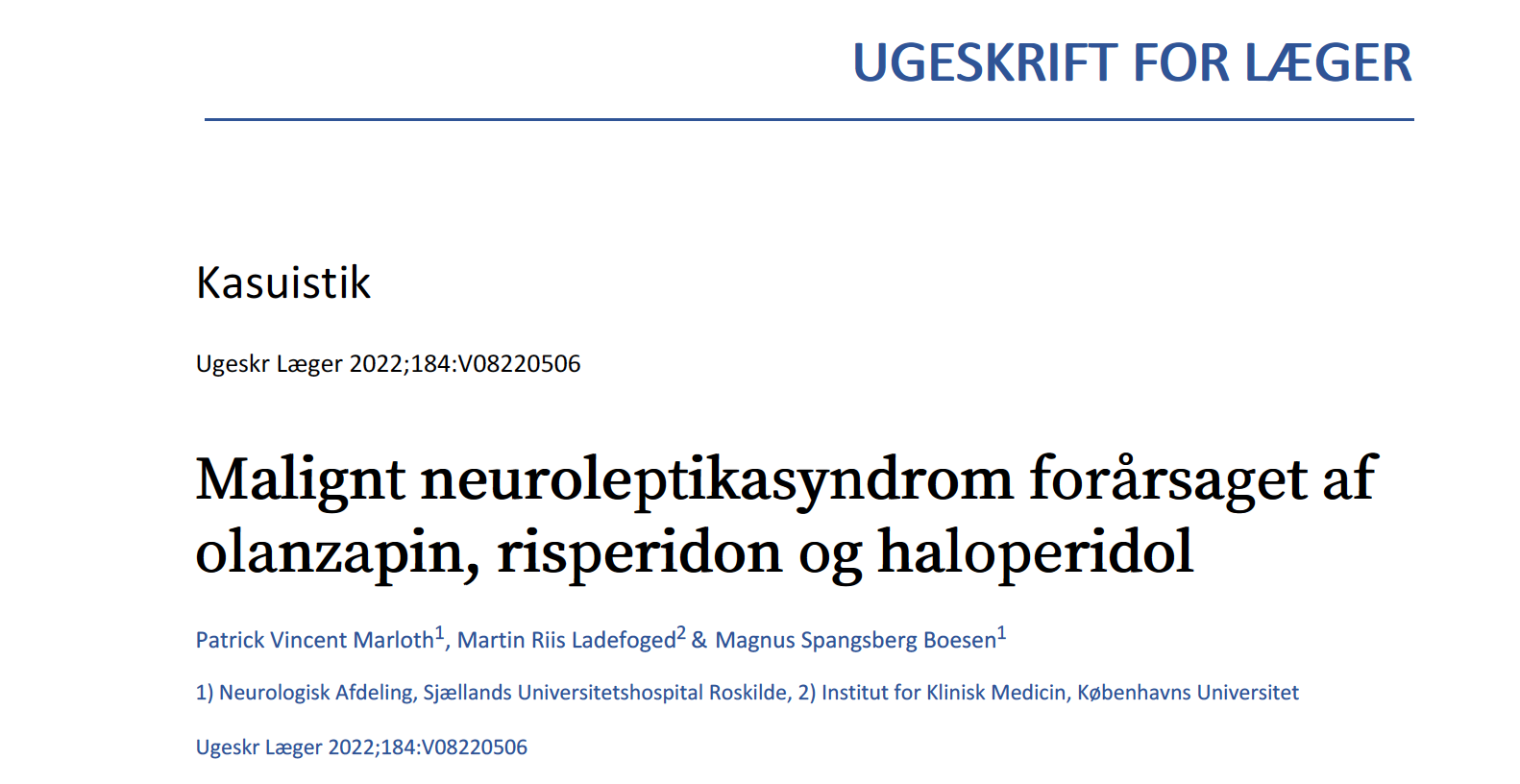Out on PubMed, from Danish clinicians, is this case report:
[Neuroleptic malignant syndrome caused by olanzapine, risperidone and haloperidol].Marloth PV, Ladefoged MR, Boesen MS.Ugeskr Laeger. 2022 Nov 7;184(45):V08220506.PMID: 36345898 Danish.
And from the text (translation by Google)
MEDICAL HISTORY
A 27-year-old man, known to have unspecified mental retardation with lack of language but with walking function
as well as the ability to eat with a knife and fork, was admitted from his place of residence. After several years of treatment with olanzapine 12.5 mg daily due to externalizing behavior and difficulty sleeping, he developed gradually increasing urinary retention, sweating and heart palpitations as well as increasing externalizing behavior, which is why he was switched from olanzapine to risperidone 2 mg daily.
During the following days, he lost the ability to walk and had a reduced level of consciousness. Objectively, he developed fever, muscle rigidity in all four extremities and jaundice. Paraclinically, elevated liver and
number of infections and elevated creatine kinase concentration of 4,500 units per liters (11 times higher than upper
reference interval). At this time he was diagnosed with neuroleptic malignant syndrome. MRI scan of
cerebrum was unremarkable and cerebrospinal fluid examination was normal.
The patient was improving, but due to extroverted and aggressive behavior towards the staff, he received a total of 10 mg haloperidol over a day, after which he relapsed. As he could not take food, he was intubated and had a longer course in the intensive care unit.
As the condition did not improve, it was decided to start up electroconvulsive therapy (a total of five treatments) and adding amantadine and dantrolene. Two and a half months after the patient lost walking function, and one month after the last electroconvulsive treatment, the patient was discharged from the intensive care unit and had regained his usual cognitive level, but had continued rigidity and was in a wheelchair.
Electroconvulsive therapy can be used if other treatments have not had an effect. The rationale is that electroconvulsive therapy is effective in treating malignant catatonia, and a meta-analysis has found lower mortality after this treatment in patients with neuroleptic malignant syndrome [4]. The treatment effect however, must be weighed against possible complications such as cardiovascular complications (ventricular fibrillation, cardiac arrest), status epilepticus or aspiration pneumonia, and these appear to be specific for electroconvulsive therapy in relation to neuroleptic malignant syndrome [5].
REFERENCEs 1. Shalev A, Hermesh H, Munitz H. Mortality from neuroleptic malignant syndrome. J Clin Psychiatry. 1989;50(1):18-25. 2. Modi S, Dharaiya D, Schultz L, Varelas P. Neuroleptic malignant syndrome: complications, outcomes, and mortality. Neurocrit Care. 2016;24(1):97-103. 3. Li P, Snyder GL, Vanover KE. Dopamine targeting drugs for the treatment of schizophrenia: past, present and future. Curr Top Med Chem. 2016;16(29):3385-3403. 4. Davis JM, Janicak PG, Sakkas P et al. Electroconvulsive therapy in the treatment of the neuroleptic malignant syndrome. Convuls Ther. 1991;7(2):111-120. 5. Trollor JN, Sachdev PS. Electroconvulsive treatment of neuroleptic malignant syndrome: a review and report of cases. Aust N Z J Psychiatry. 1999;33(5)
Here's another case of NMS successfully treated with ECT. No ECT details, except that it was a short course of 5 treatments. Thanks to our Danish colleagues for this contribution to the ECT literature.





I am happy to see that ECT was helpful in this case, but it seesm that the patient was left unable to walk, perhaps because the initiaiton of ECT was delayed. Our medical/surgical colleagues are sometimes too slow to refer patients with NMS, or status epilepticus, or globus pharyngeus complicated by severe weight loss - with the the result that the patient is better but left with residual disability. We all need to advocate for quicker consideration of ECT in these devastating conditions
ReplyDelete